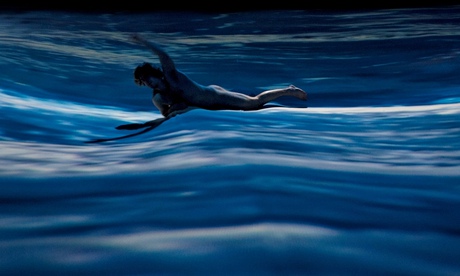
When Orson Welles staged "the supremely unstageable" Moby-Dick in the West End in 1955, Observer critic Kenneth Tynan dubbed it "a piece of pure theatrical megalomania – a sustained assault on the senses which dwarfs everything London has seen since, perhaps, the Great Fire".
What, one wonders, would Tynan have made of Living Structures' homage to Herman Melville's novel, with its giant, amorphous inflatables, its rubber-clad aerialists and its walk-through whale's stomach? The show's trailer shows naked swimmers front crawling across an ocean and huge rubber balls bouncing over the audience's heads. Staged across 9,000 square feet of Hackney warehouse, Leviathan looks set to live up to its name.
Reading on mobile? Click here.
"We could have gone miniature," admits director Klaus Kruse, "using puppetry and relying on the audience's imagination, but we wanted to give you an actual sense of that enormity. We're trying to create large, impressive spaces."
That's what Living Structures do. "We work with space and the transformation of space around an audience. We tell stories through journeys." Their last London show, Cart Macabre, which played the Old Vic Tunnels in 2010, took audiences to hell on a handcart. We were wheeled off on mortuary slabs and folded into boxcars as part of a pitch-black fairground ride through the underworld. Skeletal sailors formed chorus lines. Hands ripped apart a bloody heart. Butterflies flew into candles, flapping as the flames took hold. It was a heady trip, as dizzying as diesel fumes.
If that was a passive, chauffeur-driven experience, Leviathan will be much more active. Audience members stand in for members of Captain Ahab's crew. We're given chores, lugging giant slabs of blubber and hauling in the rigging, as we follow him on a quest to track down the iconic sperm whale. It's all very abstract, though. "At the end of the event, we all communally and symbolically drown," says Kruse.
Therein lies the piece's politics. What appealed to Kruse about Melville's text was "the idea of this one person leading a whole ship to doom. That felt really contemporary. One spaceman can take a whole country to the moon. One politician can save an entire people." You might well add the one rogue reporter it takes to topple a newspaper, or the one bad bank needed to trigger economic freefall.
"It's not an overtly political play, but rather an experiential thing," Kruse continues, likening the audience "to a mass demonstration or a football stadium crowd". It's a case of using space and crowd-dynamics to convey meaning and tell a story and, as such, Living Structures try to find a different role for their audience in every show. That decision, like their Russian constructivist aesthetic, is rooted in the avant garde of the 1920s and Antonin Artaud's Theatre of Cruelty. "People really started to consider that relationship between audience and performer, not just for the convenience of sightlines and acoustics, but to discover the way audience and performers share a space." Almost a century on, theatremakers are still asking the same questions.
• From 15-26 July at the Hackney Downs Studios, E8 2BT. Box office: 0871 220 0260. Venue details.

